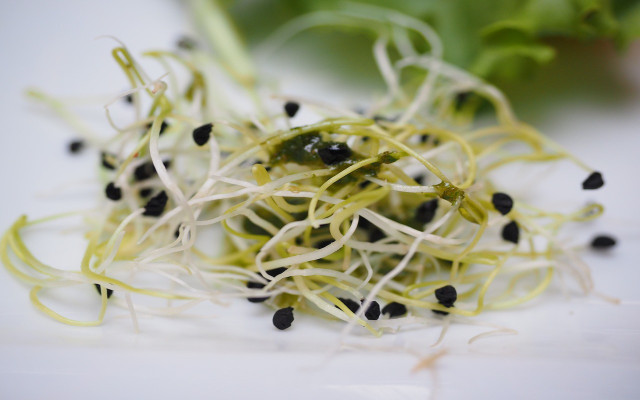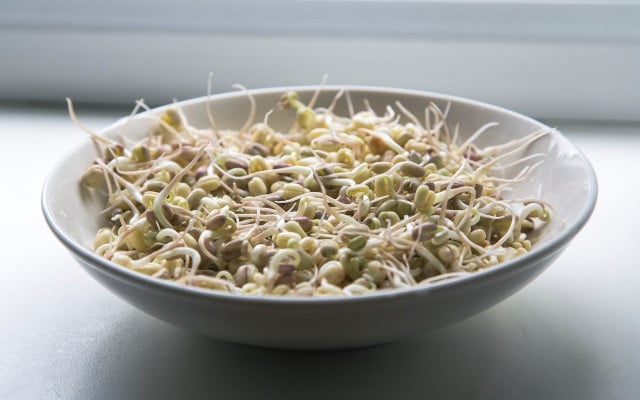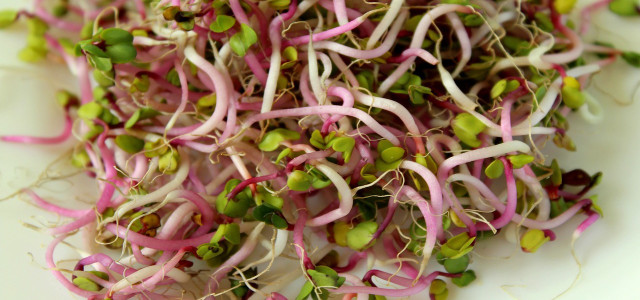Crunchy sprouts are the easiest superfood to grow at home. Whether you choose to grow sprouts from alfalfa, lentils, radishes, peas or mung beans, these high-quality foods are rich in vitamins and minerals. We’ll look at how to grow sprouts in a jar at home.
Light, air, and water — that’s all sprouts need to thrive. Growing sprouts in a jar at home means you’ll have fresh greens in the kitchen and on your plate all year round. Sprouted seeds are not only easy to handle, but they also have a lot to offer: vegetable protein, vitamins, fiber, and minerals make them a valuable companion, especially for vegan nutrition. We show you how easy it is to grow sprouts at home.
How to Grow Sprouts in a Jar: Soak, Rinse and Wait

To grow sprouts at home, you’ll need a sprouting jar, which you can buy in organic or health food stores, or online on Amazon**. The advantage of special sprouting jars is that excess water can drain off so the sprouts don’t sit in water. You will also need a sprout mix of your choosing; just be sure to look for organic sprouting seeds (like these on Amazon**). You can also find them in most organic and health food stores.
Here’s how to get started:
- Put a tablespoon of seeds in a sieve and rinse them under running water.
- Place the rinsed seeds in a sprouting jar and cover them with twice the amount of water.
- Let the seeds soak for one to eight hours, depending on the seed mix, and then pour off the water. The exact soaking time can usually be found on the seed package.
Tip: Use the soaking water of the sprouts to water your plants!
- At the end of the soaking time, pick out any empty seed shells and seeds that haven’t sprouted. These won’t germinate and could actually end up rotting in the moist environment of the jar. Definitely not something you want to be eating!
- Return the swollen seeds to the germination jar and screw in the strainer insert on top. Turn the jar upside down and lean it at an angle. This will allow excess water to drain off and collect on the plate.
To grow the sprouts, rinse the jar with the sprouts two to three times a day with water (check package instructions) and place it back on the saucer to drain. To do this, you can simply let the water run through the lid, swirl it a few times in the jar and drain it again through the closed lid.
Quick Harvest
Depending on the variety, you can harvest fresh sprouts after just four days and use them to give your salad or sandwich a nutritional boost. While it’s best to use the sprouts as soon as possible, you can also store them in the fridge for up to two days.
By the way, you can clean the sprouting jar completely in the dishwasher — and then start all over again and grow new sprouts.
Things to Look Out for When Growing Sprouts at Home



Remember to be careful when eating sprouts: because a humid environment at room temperature is a perfect breeding ground for mold, it’s best to pay attention to the following points when you start growing sprouts in a jar:
- Quality: Use organic seeds and only those that are specifically intended for sprout cultivation.
- Don’t use too many seeds: One to two tablespoons is enough.
- Proper Temperature: When growing sprouts, the room temperature should not be below 64°F and not above 72°F.
- Routine: Rinse the sprouts with water several times a day. Make it part of your routine, like in the morning after getting up and again when you get home from work.
- Do the sensory test: Do the sprouts smell musty? Do they look funny? If they do, start over.
- Note: The fibrous roots sometimes form a small white fuzz (especially with radishes) — don’t confuse it with mold.
- Hygiene: Sterilize the jar with hot water after each sprouting cycle or put it in the dishwasher with the lid.
Sprouts in a Jar: Use Caution



As you can see, growing sprouts couldn’t be easier. Plus, if you follow these rules when growing sprouts at home, you can enjoy healthy and fresh sprouts regularly. However, as a precaution, the British National Health Service (NHS) advises risk groups such as people with weakened immune systems, small children, senior citizens, and pregnant women not to eat raw sprouts raw. This is due to the fact that bacteria (like Salmonella, Listeria, and E. coli) can get into the sprouts through cracks in the seed shells, and then continue to thrive in the moist, warm environment.
To avoid contaminated sprouts in a jar, it’s recommended to blanch them before using them. Simply place the sprouts in a sieve and immerse the sieve for half a minute in a pot of boiling water. Then rinse the sprouts in cold water before adding them to your dish!
This article has been translated from German by Karen Stankiewicz. You can find the original here: Sprossen ziehen: So gelingt es
** Links to retailers marked with ** or underlined orange are partially partner links: If you buy here, you actively support Utopia.org, because we will receive a small part of the sales proceeds. More info.Do you like this post?






